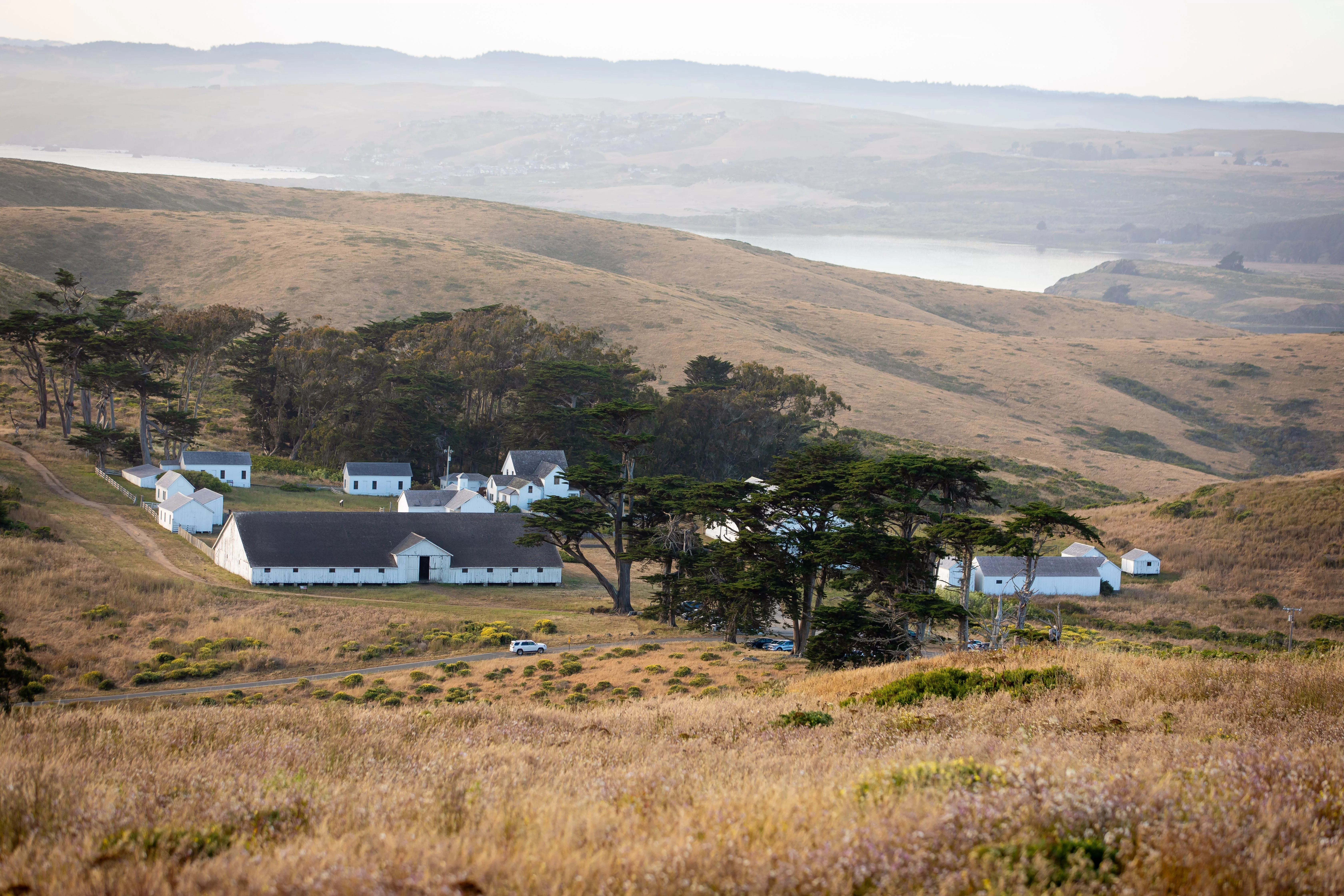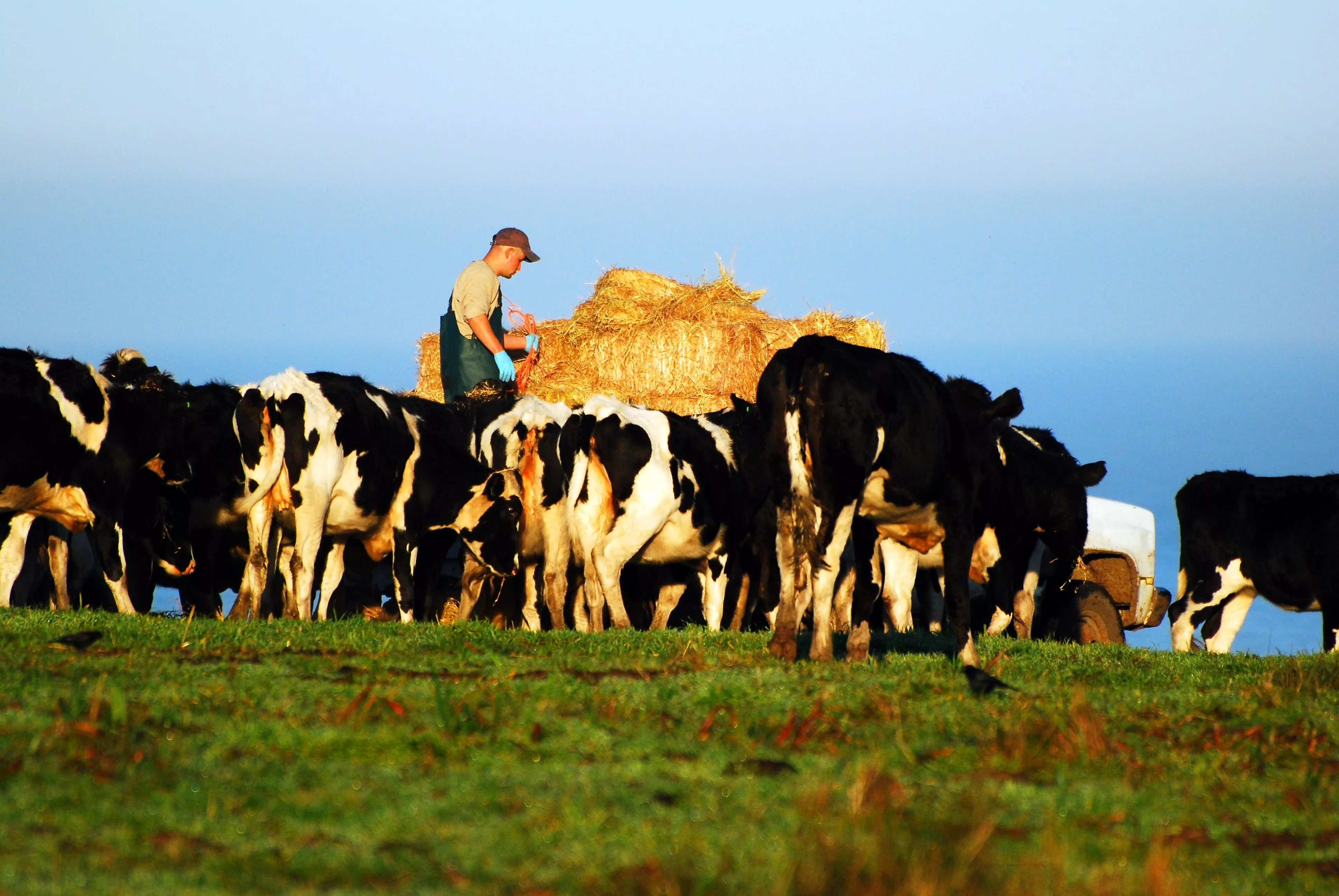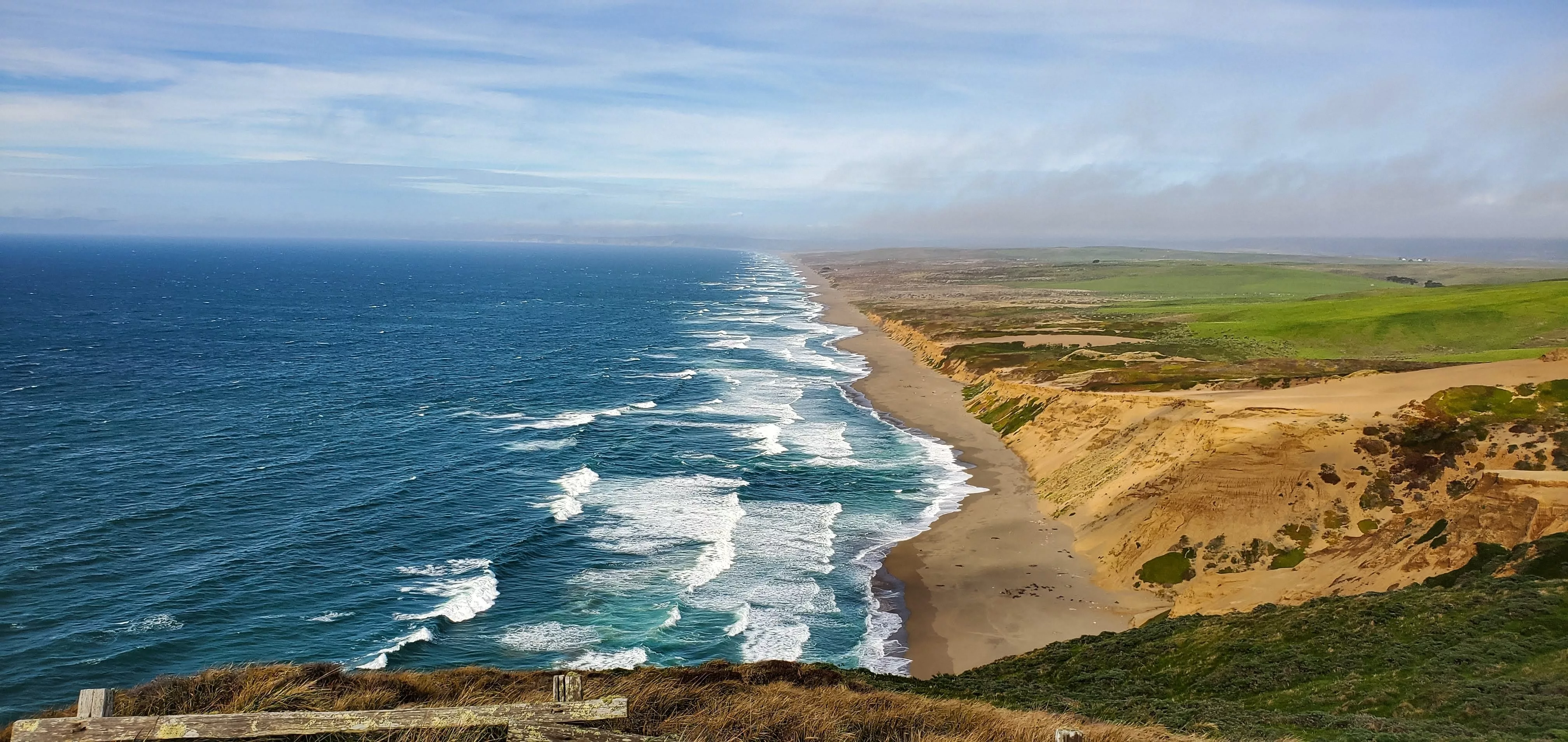
Pierce Point Ranch in Point Reyes was one of the largest operating dairy ranches in the state at the turn of the 20th century. Today, it is listed on the National Register of Historic Places and is open to the public as an interpretive site.
Cattle have roamed across the pastoral lands of the Point Reyes peninsula for almost two centuries.
Close to the Pacific Ocean, surrounded by nature, they create an idyllic picture—though one that’s illusory in modern times. Behind the scenes, ranchers, environmentalists and the National Parks Service have been involved in an increasingly contentious relationship for more than a decade, with each holding different beliefs about the appropriate use of the Point Reyes National Seashore’s ranchlands. Now, a resolution is at hand as the result of a negotiated settlement, and the majority of the seashore’s ranch families are preparing to vacate their properties in a move that’s left a close-knit community devastated.
The roots of the conflict go back to the 1960s and an era of rapid development, when plans for housing, a major highway and urbanization threatened the lifestyle of rural west Marin County. Ranchers, environmentalists and local residents banded together to fight a common enemy and proposed creating a national seashore as a strategy to protect the land.
Congress passed legislation in favor of the creation of the Point Reyes National Seashore (PRNS) in 1962, and President John F. Kennedy signed it into law later that year. To make the new seashore a reality, however, the National Parks Service first needed to purchase the land that the ranches occupied, which took 10 years. PRNS was officially established in 1972, and it included a pastoral zone, allowing the ranches to stay and continue operations with 20-year leases and special grazing permits.
Those leases are at the heart of the dispute, because they came with different expectations.
While the ranchers assumed the NPS would renew the leases for as long as their families wanted to continue ranching, the environmentalists thought that once the initial 20-year leases expired, the land would return to nature, relegating the ranches to history. Instead, when the leases began to expire in the 1990s, the NPS converted them into ongoing five-year leases. In 2014, then-Secretary of the Interior Ken Salazar ordered longer leases, and the NPS began seeking ways to comply. Meanwhile, environmentalists believed long-term leases went against the original vision, setting the stage for litigation.
In 2016, the Resource Renewal Institute, based locally in Fairfax, the Center for Biological Diversity, which is based in Tucson, Arizona, and the Western Watersheds Project in Hailey, Idaho, filed suit in federal court to challenge the NPS’s decision to issue 20-year leases to commercial beef and dairy ranches without first gathering public input and conducting an environmental review, which the National Environmental Policy Act requires. “Through the park’s entire history, there had never been an Environmental Impact Report,” says Chance Cutrano, RRI’s director of programs.

In an attempt to address the complaints, PRNS asked for public input and completed an updated management plan, which it released in 2021. Cutrano points out that the management plan went beyond ranching, however, and allowed expanded commercial activities—including diversified agriculture, short-term vacation rentals, a mobile slaughterhouse, as well as a cap on the number of tule elk that could live within the boundaries of PRNS.
Meanwhile, sustainability and fragile ecosystems had become a concern in a new era facing climate and diversity crises—and environmentalists believed the plan failed to adequately consider the effects of drought on water, managing wildlife and climate change. “With all of those things, we felt that the park’s proposed course of action violated both the national parks’ enabling legislation and legislation that created the national seashore,” Cutrano explains.
In 2022, the plaintiffs sued again to stop implementation of the updated management plan, charging that it was still in conflict with the PRNS’s enabling legislation and contrary to the NPS’s founding mandate. The litigants hired a private mediator, Bradley O’Brien of Conflict Resolution LLC, but no easy solution was in sight.
Meanwhile, the National Parks Service asked The Nature Conservancy—one of the largest nonprofit environmental organizations in the U.S.—to conduct negotiations with the ranchers. The Western Resources Legal Center at Lewis & Clark Law School in Portland, Oregon, who are experts in environmental law, represented the ranchers pro bono.
The outcome was an announcement on Jan. 8, 2025, that 11 leaseholders who operate 12 ranches—six dairy and six beef—would cease operations and leave PRNS in 15 months, with The Nature Conservancy (TNC) raising the funds to buy the leases from the ranches and retire them. Although the negotiations were confidential and the financial terms were not released, the Point Reyes Light reported that the amount required was an estimated $40 million. (Public funds cannot be used, because Congress previously appropriated funds to buy the properties in the 1960s and ’70s.) The NPS will negotiate new 20-year leases with an additional two ranches that were not part of the negotiations, as well as another seven in the Golden Gate National Recreation Area, which the NPS manages but does not own.
‘Lose-lose situation’ for all parties
Michael Bell, protection strategy director of The Nature Conservancy in California, explains that the land-use conflict had been going on for a considerable amount of time, and the NPS and plaintiffs had moved to mediation but weren’t making progress. Thus, the NPS reached out to TNC in 2022 and asked if they’d be willing to meet with all the parties and try to find alternatives that could lead to a settlement. TNC staff did some research and concluded that the existing situation was bad for the environment, the culture and the ranchers. “It was evolving into a lose-lose situation,” says Bell, explaining that they decided to become involved, but it was a decision they did not take lightly.
The Nature Conservancy has extensive experience in protecting resources, including family agricultural lands. “[And] there is a time and place where transactions can help develop a solution in an intractable situation,” Bell says.
The different players were stuck in a model that wasn’t working, and so TNC needed to find a way to move them in a more positive direction and create a better land-use model. He emphasizes that TNC is an independent actor, not a litigant or an advocate, and it didn’t have an interest in one particular outcome. Instead, “It required us to meet with families one by one and build some trust,” he says. And they framed an alternative for each family and worked with them to refine it and determine if it was acceptable. “These are big personal decisions,” he says, and so TNC left it to them to assess whether it would work for them or not.

Any solution also had to satisfy the environmentalists, but TNC did not have any discussions with them. Instead, they took the suggested solutions to their attorneys, who in turn presented them to their clients. In addition, the final agreement had to accommodate the planning process of PRNS, and so the National Parks Service, which wasn’t involved in the confidential negotiations and didn’t meet with any of the parties, had to agree to the terms. In the end, with give and take on all sides, TNC brokered a settlement agreement that all key players could live with, even if it didn’t give them everything they wanted.
Bell observes that if mediation had not been successful, a judge could have made a decision that allowed the conflict to continue, or the dispute might have come to an abrupt end without support to help people through the transition. “It was better to do it with a plan and resources and create a pathway for PRNS,” he says, although the local controversy made the process difficult. He points out that local concerns about agriculture are valid and important, but PRNS is a national seashore that belongs to the people of the United States, and so stakeholders across the country have a vested interest and opinions that count. “That’s frequently forgotten,” he says. “What’s appropriate for a national park doesn’t necessarily benefit the local community.”
He adds that the depth and duration of the problem was also a challenge. “We didn’t have a blank canvas to create a solution,” he says, but instead had a narrow window to find one and reach an agreement while dealing with a challenging set of conditions and restraints.
Winds of change
The Lunny family has lived on the G Ranch in Point Reyes for more than 75 years, and it’s the only address third-generation rancher Kevin Lunny, 67, has ever known. His grandfather acquired the ranch in the 1940s after World War II. “He actually got into the ranching business by accident,” he says, explaining that he was the general manager of a global steamship company in San Francisco and signed a note for a distant relative who wanted to buy a dairy in Point Reyes, but couldn’t qualify for a loan.
The man never did take over the ranch, and “My grandfather had a dairy on his hands,” he says. He didn’t know where Point Reyes was but decided to take a sabbatical to experience farm life and found that he loved living on the ranch and stayed. Kevin’s father, Joe, was a sophomore at St. Ignatius Preparatory School in San Francisco at the time and skipped a year of school to work on the ranch and then went to Tomales High School, where he took agriculture classes and fit right in. “He’s 94 and still on the ranch,” he says, and he helps where he can, sometimes herding cows to get them on the right side of the fence.
Lunny believes that when the Point Reyes National Seashore was created, Congress wanted to preserve agriculture, and the intent was to allow ranching to continue, not stop it.
“When the park first took over, things were good,” he says, but about 20 years ago, things started to change. The first sign that agriculture was at risk came in 2011, when Salazar decided against renewing the lease that Lunny held on Drake’s Bay Oyster Farm on Drake’s Estero, forcing the business to close in 2014. “That was when we really saw a change,” he says, and the ranchers started to wonder if they might be next. Then, justifying their fears, the NPS imposed new requirements, such as reducing the number of cattle they were allowed to have, requiring increased reporting and implementing new regulations that made it harder for the ranches to survive.
Finally, negotiations came with the offer of a buyout. And, although the agreement to sell each lease was voluntary, Lunny still describes it as “tragic.”
“None of us are happy with it,” says Lunny. “My dad came to this decision before we did. No matter what you do, you’re going to have the same landlords, and it becomes untenable. That doesn’t make it easy; it’s super difficult.” Still, a whole host of reasons led his family to accept the offer. “We all dearly love where we are,” he says.
But Lunny recognized that the challenges weren’t going to go away, and the lawsuits and attacks on agriculture were likely to continue. “It was becoming clear that our future was in trouble no matter what,” he says Starting over in ranching elsewhere isn’t financially feasible—so he, his wife Nancy and his father will likely move to Auburn, where they hope to keep a connection to agriculture and grazing, perhaps keeping a few cows. He observes that every family is going through the same challenges, and it’s more than just ranching, because it impacts people at the human and family level. “Everybody has tough decisions ahead,” he says.
Among those negatively affected are an estimated 90 ranch workers and their families, who live on the ranches. As employees, the. workers were not represented in the confidential negotiations, but the closure of the ranches means they will lose both their jobs and their homes. “It’s unfortunate that they were not at the table,” says Bell. He reports that they were a source of concern and thus a critical element in negotiations, and the settlement agreement allocates an estimated $2 million to assist them. In addition, The Nature Conservancy and local partners will work with them to design and carry out a transition plan.
Next steps: restoring the land
Once the ranches go dark, “NPS lands vacated by ranchers will be rezoned as part of the Scenic Landscape Zone,” says Melanie Gunn, outreach coordinator for the National Park Service. Then The Nature Conservancy will work directly with the Federated Indians of Graton Rancheria, a partner in management of PRNS, on restoration.
Graton Chairman Greg Sarris is pleased that the controversy and litigation have finally come to an end. “As the only federally recognized tribe with ancestral lands in the seashore, we look forward to working with the seashore as partners, under our co-stewardship agreement, and The Nature Conservancy as a partner, to implement cultural and natural resource management activities.”

Bell reports that TNC also hopes to collaborate with local organizations that have experience in research and land management, and he believes “it could be a really cool chapter for Point Reyes National Seashore.” He adds that they will find the best outcomes possible; among the considerations are fire-fuel management, abating weed outbreaks, creating optimal conditions for rare and endangered species, as well as restoration of coastal wetlands and grasslands. Targeted ecological grazing is also a possibility. “Our role is [as an] implementing partner in carrying out those objectives,” he says.
Devastating loss, or peace at last?
Meanwhile the close coastal community has to deal with the fallout from changes it didn’t want. Albert Straus of Straus Family Creamery has made it a mission to sustain family farming in West Marin and describes the settlement as a devastating loss to local farming and the region’s milk shed. His business depends on a thriving local network of dairy farms to produce high-quality, minimally-processed dairy products and will lose suppliers with the closures. “Marin County has already seen its number of dairies dwindle by 33% over the past decade, and losing two of our 13 supplying farms within the park poses a challenge as demand for Straus products continues to grow,” he says.
The ultimate impact on the local economy, though, is difficult to predict. Robert Eyler, an economics professor at Sonoma State University and chief economist of the Marin Economic Forum for several years, believes the loss of 12 ranches is unlikely to have a major effect. “If [the ranchers] decide to continue ranching and relocate to Sonoma County, Marin will lose, and Sonoma will gain,” he says. He explains that everything presumes a 100% loss in Marin County, and if the ranches leave the area completely, it will be a shock, but that’s still unknown. He points out that the closures will impact the workers who live on the ranches more than anyone, and if family members have other jobs locally and don’t want to give them up, “It puts more pressure on the housing market if folks intend to stay.”
Feed suppliers, veterinarians and machine repair services will also face a loss of business. “[But] until we have a little more meat on the bone in terms of information, it’s all conjecture,” Eyler says. He adds that tourism is important locally and, while that doesn’t lessen the importance of agriculture, he doesn’t think the loss of the ranches will have an enormous effect.
Bell believes that PRNS is an incredible space and a special place for many people, including tourists, and finds it unfortunate that so many people were locked in conflict for so long. “Litigation is never the best solution. By engaging and using different tools, we were able to find a solution that wasn’t there before,” he says. “We hope that helps the parks service find peace from this conflict.”
History of ranching at Point Reyes
The first ranches at Point Reyes were part of extensive land grants that the Mexican government gave to individuals between 1822 and 1846 to encourage settlement in its northern territory. Large-scale commercial operations began in 1869 and 1870, after California became part of the United States, and San Francisco law firm Shafter, Shafter, Park and Heydenfeldt acquired more than 50,000 acres of property on the Point Reyes peninsula following a legal dispute over who had title to the land. They sold the area that is now called Tomales Point to Solomon Pierce, who built Pierce Point Ranch, which is a historic site today. Oscar Shafter and his son-in-law Charles Howard Webb divided the remaining land into 32 tenant parcels that became known as the Alphabet Ranches to create a dairy district, and several of those properties are included in the current settlement agreement. The dairies that will vacate Point Reyes National Seashore by the spring of 2026 are A Ranch, B Ranch, C Ranch, I Ranch, L Ranch and J/K Ranch. The beef ranches that will cease operations are E Ranch, F Ranch, G Ranch, H Ranch, M Ranch and Home/N Ranches. 170,000 acres will transition from ranching to other purposes, and ranchers will have to decide what to do with cattle that numbered 4,729 in a recent count.—Judith Wilson



